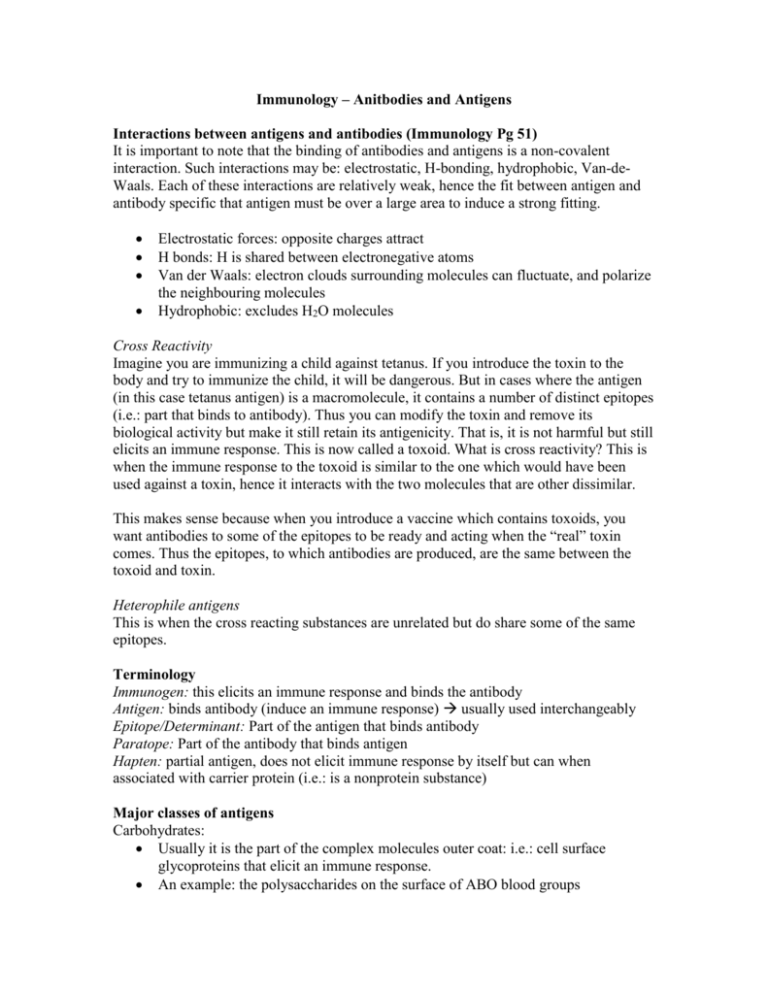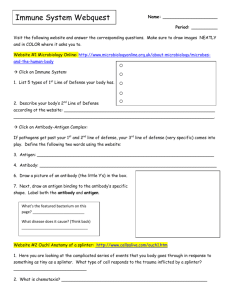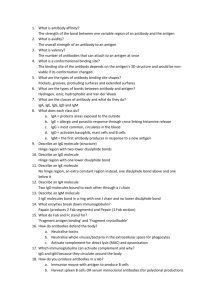Antigen & Antibodies 30KB
advertisement

Immunology – Anitbodies and Antigens Interactions between antigens and antibodies (Immunology Pg 51) It is important to note that the binding of antibodies and antigens is a non-covalent interaction. Such interactions may be: electrostatic, H-bonding, hydrophobic, Van-deWaals. Each of these interactions are relatively weak, hence the fit between antigen and antibody specific that antigen must be over a large area to induce a strong fitting. Electrostatic forces: opposite charges attract H bonds: H is shared between electronegative atoms Van der Waals: electron clouds surrounding molecules can fluctuate, and polarize the neighbouring molecules Hydrophobic: excludes H2O molecules Cross Reactivity Imagine you are immunizing a child against tetanus. If you introduce the toxin to the body and try to immunize the child, it will be dangerous. But in cases where the antigen (in this case tetanus antigen) is a macromolecule, it contains a number of distinct epitopes (i.e.: part that binds to antibody). Thus you can modify the toxin and remove its biological activity but make it still retain its antigenicity. That is, it is not harmful but still elicits an immune response. This is now called a toxoid. What is cross reactivity? This is when the immune response to the toxoid is similar to the one which would have been used against a toxin, hence it interacts with the two molecules that are other dissimilar. This makes sense because when you introduce a vaccine which contains toxoids, you want antibodies to some of the epitopes to be ready and acting when the “real” toxin comes. Thus the epitopes, to which antibodies are produced, are the same between the toxoid and toxin. Heterophile antigens This is when the cross reacting substances are unrelated but do share some of the same epitopes. Terminology Immunogen: this elicits an immune response and binds the antibody Antigen: binds antibody (induce an immune response) usually used interchangeably Epitope/Determinant: Part of the antigen that binds antibody Paratope: Part of the antibody that binds antigen Hapten: partial antigen, does not elicit immune response by itself but can when associated with carrier protein (i.e.: is a nonprotein substance) Major classes of antigens Carbohydrates: Usually it is the part of the complex molecules outer coat: i.e.: cell surface glycoproteins that elicit an immune response. An example: the polysaccharides on the surface of ABO blood groups Lipids: Rarely are immunogenic but lipids when associated with carrier proteins can be antigenic. For example lipids on surface of cell attached to membrane proteins collectively called glycolipids Nucleic acids: Poor immunogens but immunogenicity increases when associated with carrier proteins Proteins Virtually all proteins are immunogenic. The more complex the structure of the protein, the more vigorous will be the immune response. Usually proteins that are antigenic are multideterminant – i.e.: have many epitopes. What makes a good immunogen? Generally speaking here are the characteristics that will make a good and poor immunogen: Larger the better, smaller the less immunogenic Complex structures means highly immunogenic, simple structure means opposite Multiple differences to self protein means highly immunogenic, few differences will mean low immunogencity Effective interaction with MHC means high immunogenic, Ineffective interaction will mean low immunogenicity Structure of a immunoglobulin The basics Immunoglobulins are expressed in secreted form or membrane bound forms. The secreted forms are produced by terminally differentiated B cells, called plasma cells. The membrane bound antibodies are present on the outside of B cells, and these represent the place where antigens bind to. This is called a B cell receptor. Antibodies have few biological functions including: Neutralize toxins Immobilization of microorganisms Neutralize viral activity Agglutination of microorganisms (clumping together) Binding to soluble antigens precipitating them out of solution thus enhancing phagocytosis. Activate complement to facilitate lysis of microorganisms Cross the placenta barrier (class IgG) The structure Consists of two light and two heavy chains. The two heavy chains are joined by di-sulfide bonds and the heavy chains themselves are joined to the light chains by disulfide bonds. The top most region where the antibody retains antigen binding specificity (i.e.: varies with type of antigen) is called the Fab (Fragment – antigen binding). The bottom portion does not bind antigen and is known as Fc (fragment – crytalisable) and is where antigen presenting cells can bind to. One antibody recognizes one type of antigen but can bind two antigens simultaneously. When proteolytically digested using papain, the antibody molecule is cleaved at the hinge site producing two Fab regions and one Fc region (i.e. Pg 60 of Immunology book). Domains It was then found that disulfide bonds existed within each of the heavy and light chains. This is because enzymes can cleave these chains into smaller pieces but only at specific sites. It was found that light chains have two domains each, and heavy chains have 4-5 domains. The first domain on the light and heavy chains is of variable nature. This will be discussed anon. Hinge region The main function of the hinge region is to allow the flexibility between the two Fab arms of the Y-shaped antibody molecule. It allows the two Fab arms to open and close to accommodate binding to two epitopes. Variable region We know that antibodies can vary with their specificity and the variable region accounts for this. For one class of antibody (e.g.: IgM per say) there is a constant region for all specificities and a variable region. It is the variable region that binds to the epitope (i.e.: part of antigen that binds antibody). The variable regions are domains 1 on both light and heavy chains (refer to lecture notes for good picture). This means this region is the most variable in terms of amino acid sequences when you compare antibodies of different specificites from the same class. The hypervariable regions are defined as the greatest amount of variability in terms of sequences of amino acids. They found that this occurred in three regions of the L and H chains. The less variable regions between these hypervariable regions are called framework regions. Thus, the function of these hypervariable regions is to bind to the epitope of the antigen. That is why they vary between antibodies. Another word for hypervariability regions is complementarity-determining regions (CDR). Namely: CDR1, CDR2, CDR3. Actually, when the three hypervariable regions are three dimensionally brought together, they form the CDR. Isotypes of immunoglobulins Immunoglobulins are categorized into different classes. Thus, an antibody can combine with an antigen – and may elicit differing immune responses because they form part of different antibody classes. The isotypes have variations in H chains. MADGE is a good way of remembering all the classes of immunoglobulins and IgG is the predominant type found in blood, lymph, CSF and peritoneal fluid.







